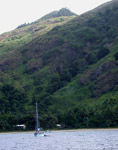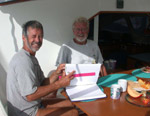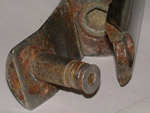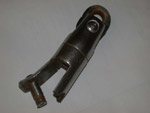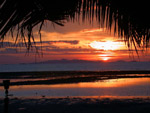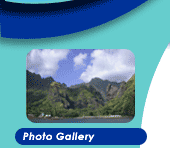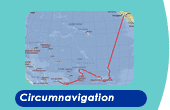November 1, 2002
|
A thin wiry man with wild black hair, wearing nothing but grimy denim cut-offs trudged up the gangway to med-moored Pacific Bliss. Stooped shouldered, he was burdened like Atlas. Conveniently draped around his neck was a piece of rusty, curved iron. He grinned as Gunter and I rushed out to meet him. “Rolf, you’ve brought our Delta anchor back from the sea!” Gunter shouted joyfully, as he gently relieved him of his heavy burden and clasped his arm around his shoulders. Pacific Bliss is now in Vuda Point Marina, being prepared for the cyclone season here, but the story begins in Fiji’s Yasawa Island Group, in Yalobi Bay off the Group’s southernmost island, called Waya. We had been experiencing winds from all points of the compass in our first two nights at anchor there. Not knowing what they call them here, we referred to them as “williwaws”, a down draft effect we had read about when the wind from the Andes cuts down to the Chilean coast. I cut to my diary entry the morning of that fateful day. Little did I know when I wrote the following, what would lie in store for us that day:
“I am tired of this howling wind,” I said. “I am tired of sailing even,” replied Gunter. I looked up in surprise. We were still in our cozy bed, knowing that there would not be a sunrise this morning, and not eager to face the elements. We had heard—or rather endured—them all night, whistling through the screens and blasting into our sleep and dreams, curling around us with tropical sea breath so strong that Gunter had reached over me to shut the window completely. At one point during the night, at 0400, I had checked the instruments. The gusts were only 20-plus knots, but they seemed like more, as they pushed around Pacific Bliss from one end of her tether to the other. I opened the salon door to see whether the full moon was still up there. It was supposed to be full two nights ago, but we hadn’t seen it yet through the ever-present cloud cover. I had so wanted Toni and Ingrid--our guests here in Fiji for two weeks--to experience the full moon, rising orange like a flattened pumpkin from the sea, but no such luck. Instead, black clouds raced furiously past the moon, swooping down from the shadows of the peaks surrounding us on three sides. “It’s these so-called ‘protective’ peaks that are creating this unwelcome williwaw effect,” I thought. “But I’ve had enough. Today we will leave this bay and its memories behind and head south, since the wind is coming mostly from the northeast.” First, we would deliver the full-size prints I had made of the chief’s brother’s family, our hosts for the sevu sevu ceremony the day before, then we would deliver prints to Adi’s Place, the backpackers’ resort we had visited, and after that, we would be on our way to Mana Island. So I thought. As the four of us had our coffee and contemplated breakfast, the gloomy skies turned darker still. The wind roared. Lightning cracked in the distance. And then the deluge began. “Guess it’s hunkering down time today,” said Gunter as he closed the salon door to shut out the noise. “Time to use our new dominoes game that you brought,” he turned to Ingrid. “And Lois, this weather should put you in the mood to complete the Easter Island story.” “Right,” I nodded and went to my starboard computer table to write. By mid-morning, patches of blue could be seen in the sky and by noon, too late to leave then, we decided to go ashore to deliver the prints and whatever… It was almost 4:00 PM by the time we returned to Pacific Bliss. Ingrid and I went inside to plan the dinner before darkness set in. Toni was out in the cockpit waiting for Gunter to come out so that they could lift the dinghy onto the davits. Sailing out first thing in the morning was now a must; they had week-end flights to catch back from Nadi to Los Angeles. The weather, for a change, seemed to be cooperating. All of a sudden, Toni cried out for Gunter. “You know that Swiss monohull in the harbor, it seems to be pulling away from us…No, I think we are the ones who are moving!” We all rushed out to the stern. Pacific Bliss was drifting, silently and inexorably, right toward the reef on the opposite bay! Gunter rushed to start the engines to get us out of the predicament while I grabbed the handheld windlass control. Chain and more chain came up. We had put out a 3:1 scope in 40 feet of water—120 feet of chain plus bridle. During the final 30 feet, I should have been able to feel the anchor, let alone see it…but it was coming up extremely rapid. Then I shouted out in amazement as rest of the chain came rushing through and wrapped around the windlass. “There’s no anchor!” “What?” said Gunter, keeping Pacific Bliss in place. By now, Rolf, from the other yacht in the harbor, was approaching us in his dinghy. “You’ve been dragging,” he yelled out. “We know,” Toni yelled back. “Come on board.” Gunter came up to the bow. Astonished, he examined the anchor’s swivel connector at the end of the chain. Indeed, it had broken, sheared sideways from the force of the williwaws. Our anchor was probably buried deep in the sand, unable to move. “Strange,” said Gunter. “The other Rolf, also Swiss, who has a Catana 431 like ours, warned me only last week that this connector is the weakest point in the anchoring system.” “Do you have a spare anchor on board?” Rolf asked. “Yes, two of them. A Fortress, which we need to assemble, and a French-made one that came with the boat.” We motored back to the bay and anchored next to Rolf’s yacht with the French Foblight aluminum anchor. Then Gunter dug through the sail locker to bring up the spare Fortress. Darkness was now upon us. I held the flashlight, while Toni and Gunter laid out the parts with the instructions. “It reminds me of the parents assembling the kids’ toys the night before Christmas,” I ventured. One and one-half hours later, with the parts still laid out in the cockpit, it was no longer funny. Rolf came back on board and joined the assembly process. Finally, he took it out with his dinghy to set it out. The five of us wearily ate our dinner and prayed for milder winds that evening. We thanked God that His Angel was still watching over us. “It could have easily happened while we were ashore today,” Ingrid commented. “Or worse yet, while we were sleeping at night,” Gunter added. “I’m glad that we only have one night left to anchor before we are back in the marina.” “Are you two going out again, then?” Ingrid asked. Gunter and I looked hard at each other, both silent for a change. Then I started to shake my head from side to side, almost imperceptibly. “No,” said Gunter. “I don’t want to press my luck.” “This cruising season is over,” I added. “Guess this is almost the end of Voyage Two.” That night, not entirely comfortable with our back-up anchors, Gunter and I woke up every so often to check the system. It was holding, but we were too close to the reef for comfort. The next morning, we said good-by to Rolf, and headed off, into the wind. Right. The bay was protected from three sides. The wind had shifted to the fourth. We motored there with the wind on the nose. We motored to Mana Island with the wind on the nose again. We apologized to Toni and Ingrid. “South seas sailing is not supposed to be like this. But this is an El Nino year…” “You know, there are three kinds of wind: no wind, too much wind, or wind on the nose…” The next night, dual-anchored off Mana Island, we didn’t dare to leave the boat. But the next morning, feeling safe tucked in the beautiful lagoon behind the island’s barrier reef, we breakfasted at the resort there and enjoyed a nice walk. Then we set sail back to Vuda Point. Fortunately, Pacific Bliss had an opportunity to shine during her last sail of the season. She slalomed between the reefs and past Navini Island, a paradise of sand and palms, making 8 knots on a broad reach, sails full in the 17-knot SSW wind. Toni viewed one shining island after another through the binoculars as the sun glinted on the occasional whitecaps and bright cumulus clouds wafted against a pale blue sky. “You know, there is another kind of sailing…”Gunter began. “I know, the way it is supposed to be,” I finished. “With fair winds and following seas.” “Makes me want to go back out here for another two weeks,” he kidded. “No way!”
“So I owe the anchor retrieval to you and also to my partner here,” Gunter was saying as we sampled Indian curry dishes. “Yes,” said Rolf. “When I contacted the divers in the village, they said they would search Yalobi Bay to find where the anchor is buried. I told them, ‘No, you will not search the entire bay. We know the exact GPS position after anchoring, the depth and length of the chain, and the wind direction. You will look there.’ Sure enough, one could see the path in the sand where the chain was dragged away. And your anchor was buried up to the hilt. It was easy to find.” “Lois is always so particular about putting everything in the logbook
when we arrive at an anchorage,” Gunter continued. “It pays off. I have
a good navigator. And I’m glad to end the season this way—we are safe,
Pacific Bliss is in good shape, and now I even have my anchor back!” Analysis by Gunter: Photos: ________________________________________________________________________
Messing with Boats, Part I by Gunter Messing with Boats, Part 2 by Lois Messing with Boats. Part 3 by Lois
journal94.html |
|
|
|
